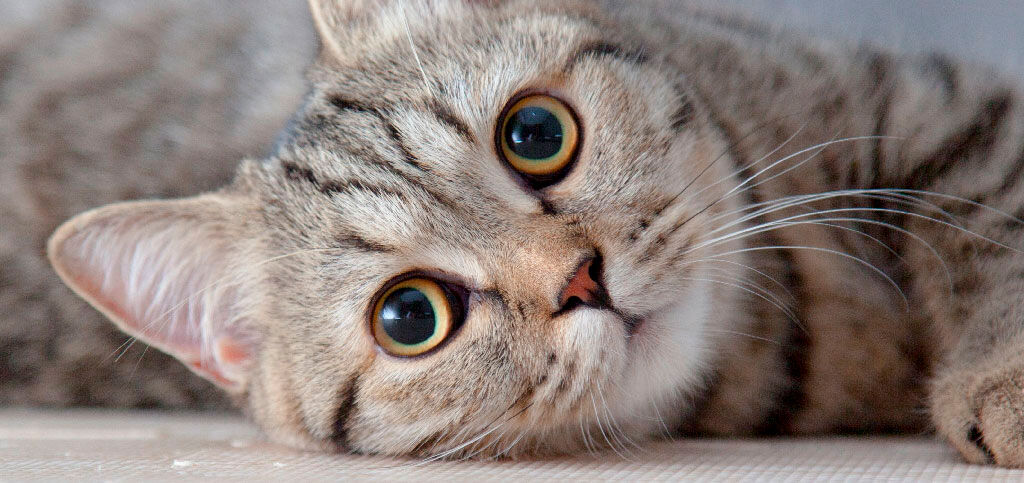Cats use olfactory, auditory and visual signals to communicate with each other and also with us. Let's take a look at the most important ones.
Olfactory signals
For cats, the sense of smell is vitally important.
Much of the olfactory communication between cats has to do with the secretion of what are known as pheromones - chemical signals that only another cat can detect (human beings can't).
When talking about the language of cats, as far as olfactory communication is concerned, we need to highlight:
- Urine marking: cats use their urine and the pheromones it contains to mark out their territory. It’s their way of telling other cats ‘this is my space’.
- Scent marking by body rubbing: cats rub themselves affectionately against us, and against certain objects because this is their way of marking us with familiarisation pheromones. This behaviour is directed only at those people who are a part of their world, and who give them protection and security.
Visual signals
Visual cues are very important in the language of cats. These are all the body positions that cats adopt that help them to express their emotions.
Tail talk
The tail is highly visible, and that’s why cats use it to send out clear messages directed at other cats and at people.
A cat’s tail tells you how he’s feeling.
Tail down
This shows that he’s feeling sad or insecure about something.
Tail up
This generally means that your cat is happy.
When a cat approaches another cat or a human being with friendly intentions, he holds his tail up to say hello. This is interesting, because the domestic cat is the only species of feline to show this behaviour, with the possible exception of the African lion.
Tail lashing from side to side
This is one of the most important signals in the cat language as it indicates that the animal is angry or upset. It’s a warning, and the next step could be biting or scratching.
That said, if the cat’s general demeanour is calm, and his tail is moving slowly, it means that he’s concentrating on something.
Gently moving tail
If the cat is relaxed, this usually indicates that he’s happy and probably feeling playful.
Straight tail with the tip to one side
Means that the cat is interested in something in his surroundings.
Arched, puffed out tail
This clearly signals threat, and is possibly the best known as it often goes with the typically arched back and hissing and spitting.
Ear talk
Ears are very important in the language of cats. Cats’ ears are incredibly mobile (they have as many 25 muscles) and are highly expressive.
Ears up
Shows that the cat is attentive and alert.
Ears back or flattened
This posture is associated with fear or anger, and is typically defensive. But be warned, a defensive position can quickly become an attacking one, if the cat feels cornered.
Eye talk
Cats’ eyes are very expressive - you just need to know how to read them.
Eyes open with pupils that are not dilated
Indicates that the cat is relaxed and happy. He feels calm and comfortable.
Dilated pupils
Indicates that the cat is ready to attack, either because he feels threatened and is frightened, or because he wants to compete for a resource (territory, food, etc.).
Direct, prolonged eye contact
In the language of cats, direct, prolonged eye contact is usually a sign of threat, as it is with dogs.
Whisker talk
Although whiskers don’t give the clearest indications of how a cat is feeling, taking note of their position does give us some clues.
Completely extended whiskers are related to a general feeling of calm. When the cat flattens them against his cheeks, this can mean that he’s frightened, or is uncomfortable or upset about something.
Auditory signals in the language of cats
Miaowing
The miaow is the main auditory signal in feline language, and can have multiple meanings. To interpret it, you need to focus on the context of the miaow.
Cats may miaow in order to:
- Ask for something
- Warn of danger
- Express pain
- Express stress of anxiety
- Say hello
- Because they are in heat
Purring
Purring is a communicative signal that cats use to communicate with us, with human beings. They never use it with other cats. It indicates pleasure, or serves to ask for something.
In this study of cat language in the magazine Current Biology, professor Karen McComb explains that it’s very possible that domestic cats have learned to purr specifically when addressing people.
But be warned, cats don’t only purr when they’re happy. Purring can also be associated with pain or discomfort.
Understanding the language of cats strengthens our bonds with them
Good communication is the basis for any excellent relationship. Understanding each other better makes us love each other more. Understanding feline language helps to strengthen your bonds with your cat, so we hope that you’ve found this article useful.
 Copy link
Copy link
 Publish on Facebook
Publish on Facebook
 Publish on Twitter
Publish on Twitter
 Publish on WhatsApp
Publish on WhatsApp
